Page 37 of 289
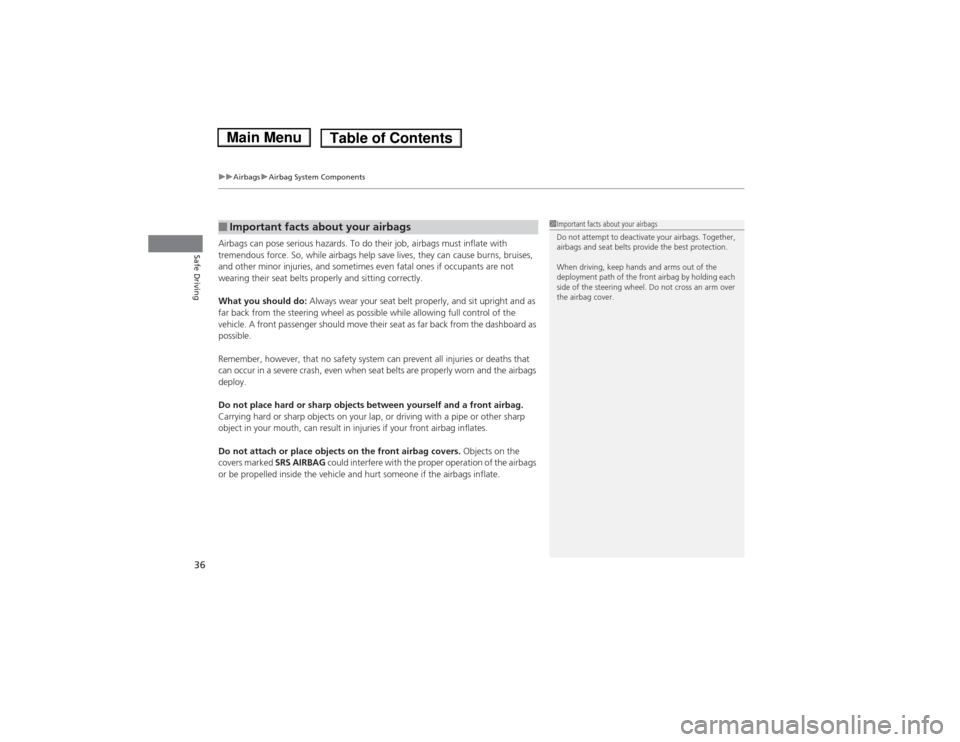
uuAirbagsuAirbag System Components
36Safe Driving
Airbags can pose serious hazards. To do their job, airbags must inflate with
tremendous force. So, while airbags help save lives, they can cause burns, bruises,
and other minor injuries, and sometimes even fatal ones if occupants are not
wearing their seat belts properly and sitting correctly.
What you should do: Always wear your seat belt properly, and sit upright and as
far back from the steering wheel as possible while allowing full control of the
vehicle. A front passenger should move their seat as far back from the dashboard as
possible.
Remember, however, that no safety system can prevent all injuries or deaths that
can occur in a severe crash, even when seat belts are properly worn and the airbags
deploy.
Do not place hard or sharp objects between yourself and a front airbag.
Carrying hard or sharp objects on your lap, or driving with a pipe or other sharp
object in your mouth, can result in injuries if your front airbag inflates.
Do not attach or place objects on the front airbag covers. Objects on the
covers marked SRS AIRBAG could interfere with the proper operation of the airbags
or be propelled inside the vehicle and hurt someone if the airbags inflate.■Important facts about your airbags
1Important facts about your airbags
Do not attempt to deactivate your airbags. Together,
airbags and seat belts provide the best protection.
When driving, keep hands and arms out of the
deployment path of the front airbag by holding each
side of the steering wheel. Do not cross an arm over
the airbag cover.
Page 38 of 289
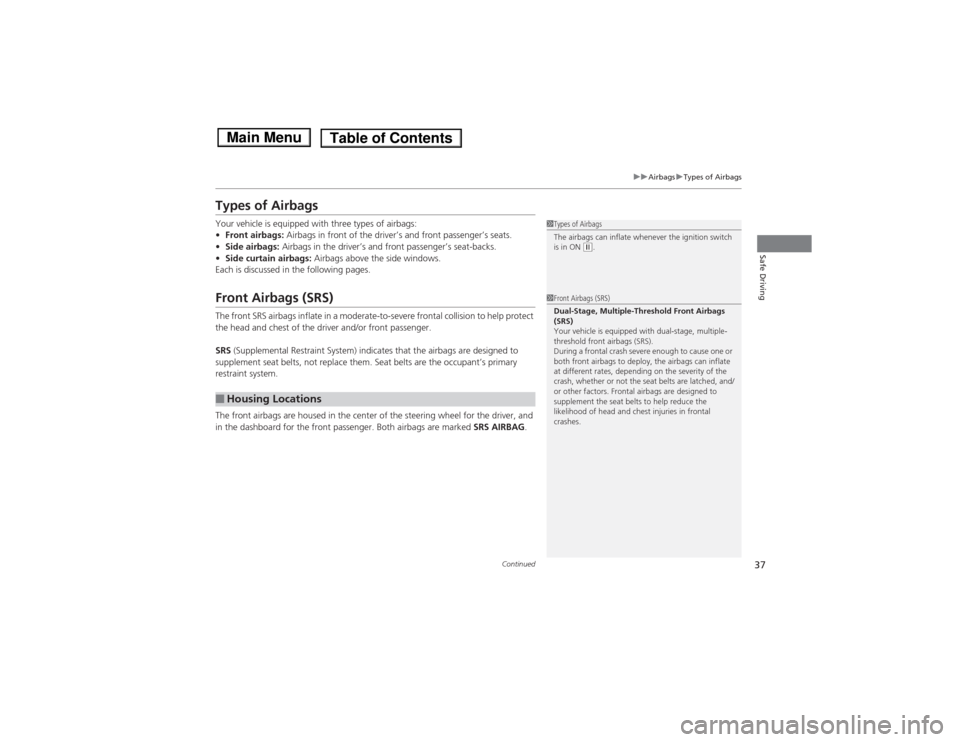
37
uuAirbagsuTypes of Airbags
Continued
Safe Driving
Types of AirbagsYour vehicle is equipped with three types of airbags:
•Front airbags: Airbags in front of the driver’s and front passenger’s seats.
•Side airbags: Airbags in the driver’s and front passenger’s seat-backs.
•Side curtain airbags: Airbags above the side windows.
Each is discussed in the following pages.Front Airbags (SRS)The front SRS airbags inflate in a moderate-to-severe frontal collision to help protect
the head and chest of the driver and/or front passenger.
SRS (Supplemental Restraint System) indicates that the airbags are designed to
supplement seat belts, not replace them. Seat belts are the occupant’s primary
restraint system.
The front airbags are housed in the center of the steering wheel for the driver, and
in the dashboard for the front passenger. Both airbags are marked SRS AIRBAG.■Housing Locations
1Types of Airbags
The airbags can inflate whenever the ignition switch
is in ON
(w.
1Front Airbags (SRS)
Dual-Stage, Multiple-Threshold Front Airbags
(SRS)
Your vehicle is equipped with dual-stage, multiple-
threshold front airbags (SRS).
During a frontal crash severe enough to cause one or
both front airbags to deploy, the airbags can inflate
at different rates, depending on the severity of the
crash, whether or not the seat belts are latched, and/
or other factors. Frontal airbags are designed to
supplement the seat belts to help reduce the
likelihood of head and chest injuries in frontal
crashes.
Page 69 of 289
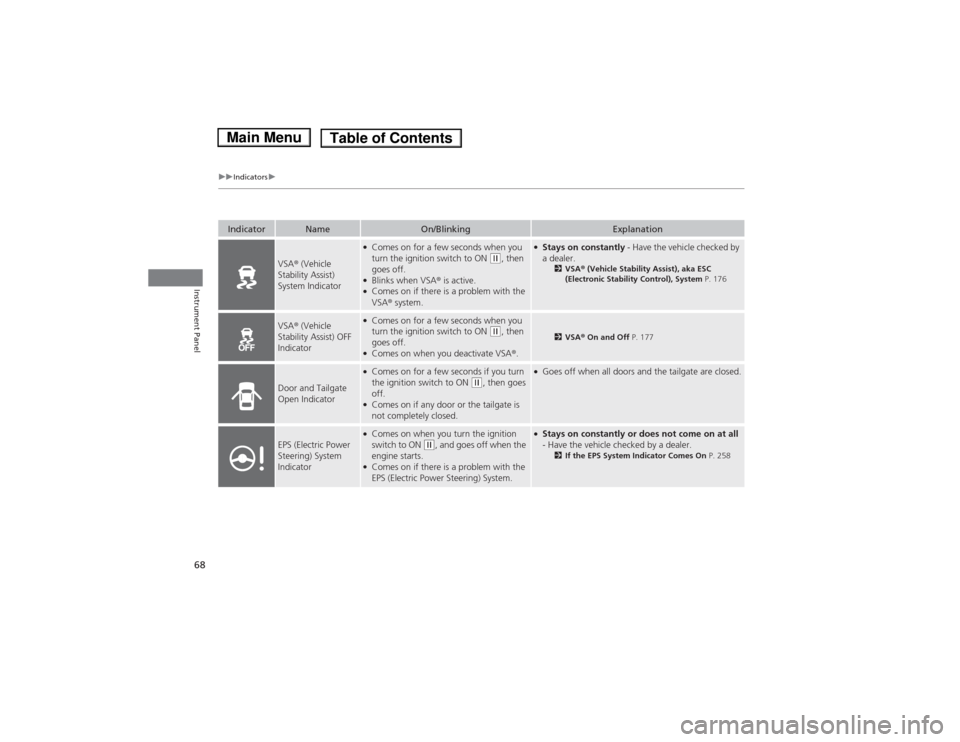
68
uuIndicatorsu
Instrument Panel
Indicator
Name
On/Blinking
Explanation
VSA® (Vehicle
Stability Assist)
System Indicator
●Comes on for a few seconds when you
turn the ignition switch to ON
(w, then
goes off.
●Blinks when VSA® is active.●Comes on if there is a problem with the
VSA® system.
●Stays on constantly - Have the vehicle checked by
a dealer.
2VSA® (Vehicle Stability Assist), aka ESC
(Electronic Stability Control), System P. 176
VSA® (Vehicle
Stability Assist) OFF
Indicator
●Comes on for a few seconds when you
turn the ignition switch to ON
(w, then
goes off.
●Comes on when you deactivate VSA®.
2VSA® On and Off P. 177
Door and Tailgate
Open Indicator
●Comes on for a few seconds if you turn
the ignition switch to ON
(w, then goes
off.
●Comes on if any door or the tailgate is
not completely closed.
●Goes off when all doors and the tailgate are closed.
EPS (Electric Power
Steering) System
Indicator
●Comes on when you turn the ignition
switch to ON
(w, and goes off when the
engine starts.
●Comes on if there is a problem with the
EPS (Electric Power Steering) System.
●Stays on constantly or does not come on at all
- Have the vehicle checked by a dealer.
2If the EPS System Indicator Comes On P. 258
Page 76 of 289

75
Controls
This chapter explains how to operate the various controls necessary for driving.
Setting the Clock................................ 76
Locking and Unlocking the Doors
Key Types and Functions .................... 77
Locking/Unlocking the Doors from the
Outside ............................................ 79
Locking/Unlocking the Doors from the
Inside ............................................... 82
Childproof Door Locks ....................... 83
Auto Door Locking/Unlocking
*.......... 84
Opening and Closing the Tailgate
Using the Key
*................................... 88
Using the Tailgate Open Handle ......... 89
Security System.................................. 90
Immobilizer System ............................ 90Security System Alarm
*...................... 90
Opening and Closing the Windows.. 92
Operating the Switches Around the
Steering Wheel
Ignition Switch ................................... 94
Turn Signals ....................................... 95
Light Switches.................................... 95
Fog Lights
*........................................ 96
Daytime Running Lights ..................... 96
Wipers and Washers .......................... 97
Brightness Control ............................. 99
Rear Defogger/Heated Door Mirror
*
Button ........................................... 100
Adjusting the Steering Wheel........... 101Adjusting the Mirrors....................... 102
Interior Rearview Mirror ................... 102
Power Door Mirrors ......................... 102
Adjusting the Seats.......................... 103
Adjusting the Seat Positions ............. 103
Interior Lights/Interior Convenience
Items................................................ 111
Interior Lights .................................. 111
Interior Convenience Items .............. 113
Heating and Cooling
*....................... 118
Using Vents, Heating and A/C
*........ 118
* Not available on all models
Page 95 of 289
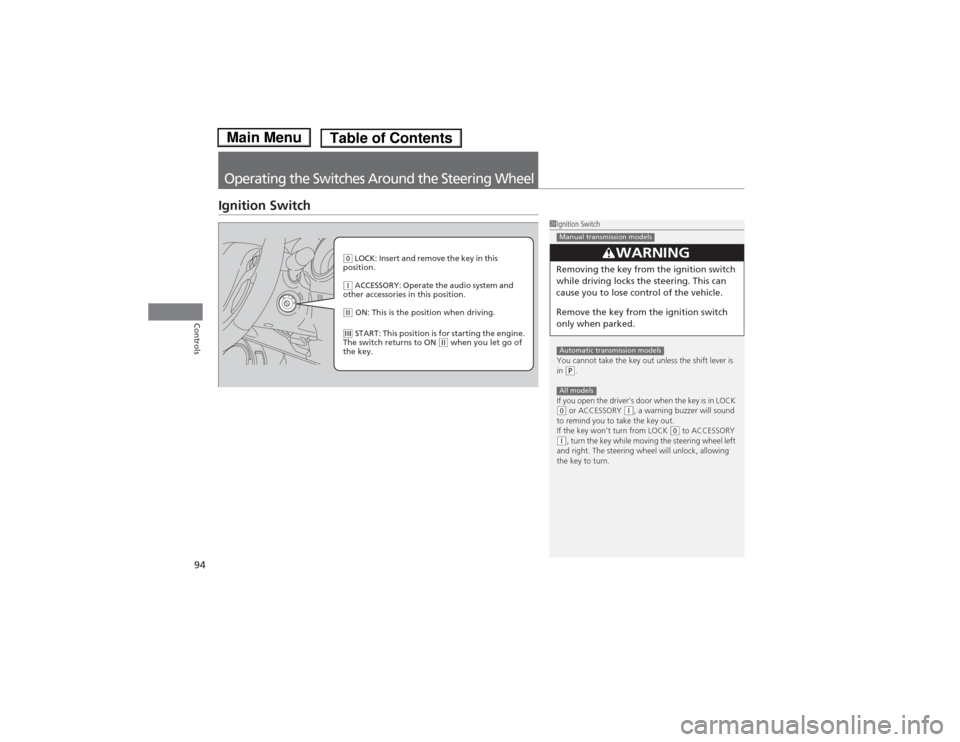
94Controls
Operating the Switches Around the Steering WheelIgnition Switch
1Ignition Switch
You cannot take the key out unless the shift lever is
in
(P.
If you open the driver’s door when the key is in LOCK
(0 or ACCESSORY
(q, a warning buzzer will sound
to remind you to take the key out.
If the key won’t turn from LOCK
(0 to ACCESSORY
(q, turn the key while moving the steering wheel left
and right. The steering wheel will unlock, allowing
the key to turn.
3
WARNING
Removing the key from the ignition switch
while driving locks the steering. This can
cause you to lose control of the vehicle.
Remove the key from the ignition switch
only when parked.Manual transmission modelsAutomatic transmission modelsAll models
(0 LOCK: Insert and remove the key in this
position.(q ACCESSORY: Operate the audio system and
other accessories in this position.(w ON: This is the position when driving.(e START: This position is for starting the engine.
The switch returns to ON
(w when you let go of
the key.
Page 96 of 289
95
uuOperating the Switches Around the Steering WheeluTurn Signals
Controls
Turn Signals
The turn signals can be used when the ignition
switch is in ON
(w.
Light Switches
Rotating the light switch turns the lights on
and off, regardless of the position of the
ignition switch.■High beams
Push the lever forward until you hear a click.■Low beams
When in high beams, pull the lever back to
return to low beams.■Flashing the high beams
Pull the lever back, and release it.
Right Turn
Left Turn
1Light Switches
If you remove the key from the ignition switch while
the lights are on, a chime sounds when the driver’s
door is opened.
Do not leave the lights on when the engine is off
because it will cause the battery to discharge.
High Beams
Flashing the high beams
Low Beams
Turns on parking, side marker,
tail, and rear license plate lights
Turns on headlights, parking, side
marker, tail, and rear license plate
lights
Page 97 of 289
96
uuOperating the Switches Around the Steering WheeluFog Lights
*
Controls
Fog Lights
*
When the low beam headlights are on, turn
the fog light switch on to use the fog lights.
Daytime Running LightsThe high beam headlights come on slightly dimmer than normal when the following
conditions have been met:
•The ignition switch is in ON
(w.
•The headlight switch is off, or in .
•The parking brake is released.
The lights remain on even if you set the parking brake. Turning off the ignition
switch will turn off the daytime running lights.
The high beam headlights return to the original brightness once the headlight
switch is turned on.
1Fog Lights
*
When the fog lights are on, the indicator in the
instrument panel will be on.
2Fog Light Indicator
* P. 70
Fog Light Switch
* Not available on all models
Page 98 of 289
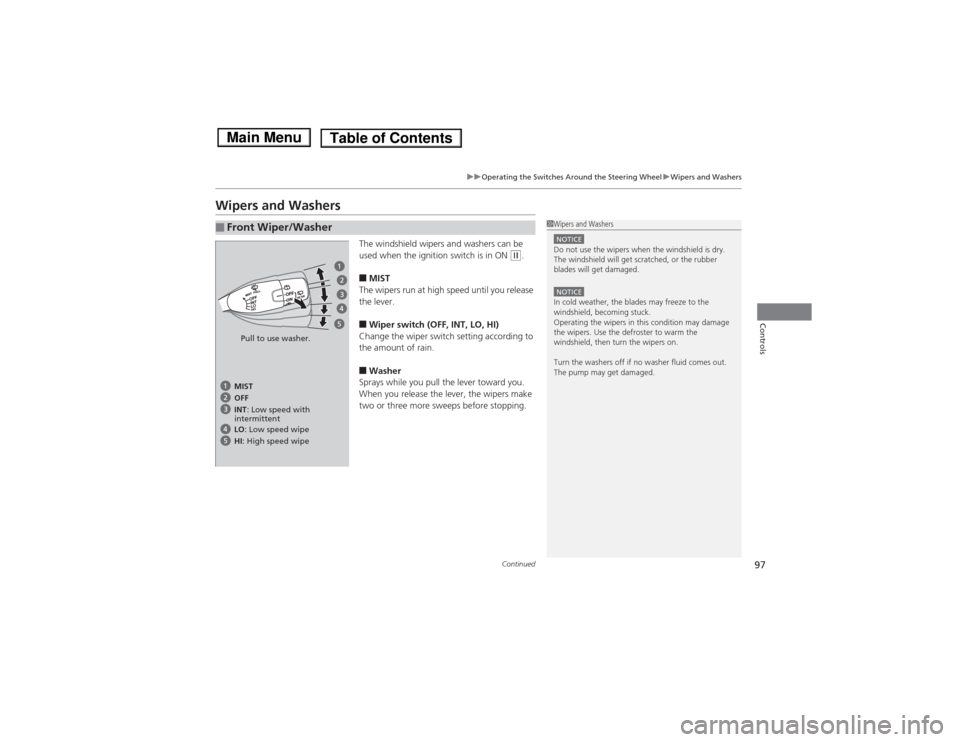
97
uuOperating the Switches Around the Steering WheeluWipers and Washers
Continued
Controls
Wipers and Washers
The windshield wipers and washers can be
used when the ignition switch is in ON
(w.
■MIST
The wipers run at high speed until you release
the lever.■Wiper switch (OFF, INT, LO, HI)
Change the wiper switch setting according to
the amount of rain.■Washer
Sprays while you pull the lever toward you.
When you release the lever, the wipers make
two or three more sweeps before stopping.
■Front Wiper/Washer
1Wipers and WashersNOTICEDo not use the wipers when the windshield is dry.
The windshield will get scratched, or the rubber
blades will get damaged.NOTICEIn cold weather, the blades may freeze to the
windshield, becoming stuck.
Operating the wipers in this condition may damage
the wipers. Use the defroster to warm the
windshield, then turn the wipers on.
Turn the washers off if no washer fluid comes out.
The pump may get damaged.
Pull to use washer.MIST
INT: Low speed with
intermittent OFF
LO: Low speed wipe
HI: High speed wipe